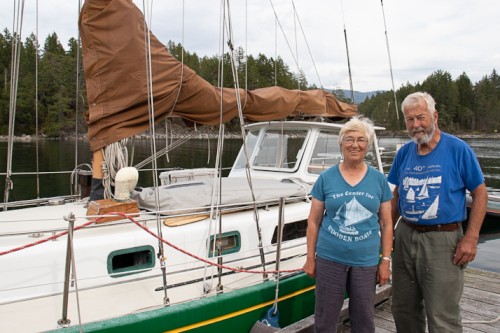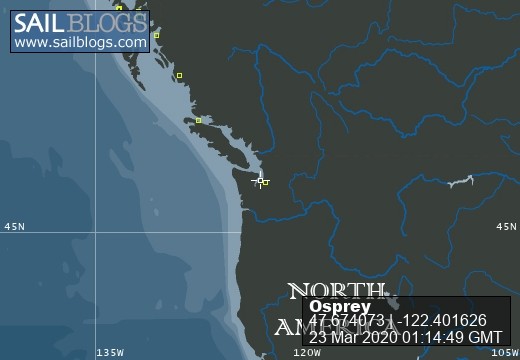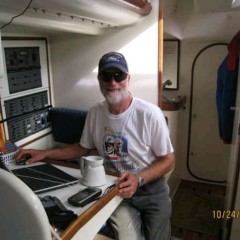Voyages North
23 July 2023
21 August 2021
11 July 2021 | Posted in Seattle
16 May 2021
07 January 2021
10 April 2020 | Posted in Seattle
31 August 2019 | Posted at Port McNeill
31 August 2019
30 August 2019
30 August 2019 | Posted at Port MCNeill
13 August 2019 | Posted at Prince Rupert
13 August 2019 | Posted at Prince Rupert
03 August 2019 | Posted at Ketchikan
02 August 2019 | Posted at Metlakatla
02 August 2019 | posted in Metlakatla AK
22 July 2019 | Posted at Klawock/Craig
22 July 2019 | Posted at Klawock/Craig
09 July 2019 | Posted at Juneau
09 July 2019 | Posted at Juneau
27 June 2019
Tracy Arm. June 12, 2015
23 June 2015 | posted at Skagway
Elsie Hulsizer

Photo: South Sawyer Glacier
We made a 90 degree turn around a barren wall of gray rock pocked with gouges. In a few feet the vegetation changed; forests of dark green spruce and hemlock gave way to low bushes of bright green. A short distance farther, the bushes thinned to mere green lines outlining breaks in the rocks. Then Sawyer Island came into view and I knew we were approaching the glaciers. But something was missing - ice. On our two previous trips up Tracy Arm, in 2006 and 2007 we negotiated fields of growlers and bergie bits at this point. But this time we saw only open water.
We had left No Name Cove at the entrance to Tracy Arm at 9:00 that morning, motoring up the long fjord. Our goal was to get close enough to both of the two glaciers in this arm to see how they had changed since we had last been here in 2007.
With us was our friend Gary Parker and his crew, Jody, who had left their boat in the Cove. With four people on board instead of two to watch for ice, we thought it would be safer. So far, there had been little ice to avoid.
As we passed Sawyer Island, the immense blue face of South Sawyer Glacier came into view and ice became more plentiful, although nothing like in previous years. Almost all of it was small growlers rather than larger bergie bits and icebergs. It got thicker closer to the glacier and we could see the black dots of seals hauled out on the ice. Off to the left a tour boat drifted in the ice and we turned our engine off too and let the currents take us where it would.
I walked up to the bow to see the glacier clearer. A chill wind blew down the inlet and drove me back to the warmth of the cockpit. We were now close enough to some of the seals to see that many of them were mothers and pups.

Photo: seals on the ice
Steve pointed to the chart plotter screen, which showed our boat high and dry where the glacier had once been; clear evidence the glacier was retreating.
We drifted, eating lunch, watching the seals and listening to the occasional boom of the glacier, much quieter than on our previous trips. Eventually ice started to crowd us. Steve backed the boat away, avoiding the seals as best as he could, then turned around and wove our way out of the ice. At one point, he drove Osprey between two small pieces of ice only to discover they were connected below the surface, roughly at the depth of our keel. We hit, then rode over the saddle without damage.
We motored into the north arm, looking for Sawyer Glacier. The sides of the fjord were bare rocks, colored orange and brown, beautiful and desolate at the same time
"I don't remember having to go this far to get to the glacier before," said Steve. Neither did I. In fact, I was beginning to wonder if it was still there. The only ice we saw was a thin line of slush.
Finally, we turned the corner and saw the glacier. With no ice in front of it, Steve drove the boat to within 1/8 of a mile of the glacier face before backing off at the protests of the rest of us. It might not be calving now, but we could see fissures in the dark blue ice and every once in a while, hear a loud crack.

Photo: Sawyer Glacier.
Again, we looked at the chart plotter. The little bug of our boat was solidly aground while the real boat was in 150 m of water. I felt disoriented, as if we were in danger, while clearly we were not.
Later, we compared the photos I had taken of the chart plotter this year and in 2007. Our 2015 location was 2/3 of a mile upland from our 2007 position.
We had gone up Tracy Arm this year because we wanted to see the differences between 2007 and now. We had heard rumors that North Sawyer Glacier had grounded but no ground was visible at its face and the water was deep 1/8 a mile off. But both glaciers are obviously retreating dramatically. It was sobering to see the changes in just 8 years.
Glaciers are like conveyor belts of ice moving down the mountain. To keep them moving they require more ice building up at the top. SE Alaska had a warm winter and warm spring with little snow accumulation. The lack of ice in the water in front of glaciers may have been the effect of the low snow accumulation. But the lack of ice allowed us to get closer to the glaciers than in previous years and see more clearly their retreat. That had been worth the trip up Tracy Arm to see.
We made a 90 degree turn around a barren wall of gray rock pocked with gouges. In a few feet the vegetation changed; forests of dark green spruce and hemlock gave way to low bushes of bright green. A short distance farther, the bushes thinned to mere green lines outlining breaks in the rocks. Then Sawyer Island came into view and I knew we were approaching the glaciers. But something was missing - ice. On our two previous trips up Tracy Arm, in 2006 and 2007 we negotiated fields of growlers and bergie bits at this point. But this time we saw only open water.
We had left No Name Cove at the entrance to Tracy Arm at 9:00 that morning, motoring up the long fjord. Our goal was to get close enough to both of the two glaciers in this arm to see how they had changed since we had last been here in 2007.
With us was our friend Gary Parker and his crew, Jody, who had left their boat in the Cove. With four people on board instead of two to watch for ice, we thought it would be safer. So far, there had been little ice to avoid.
As we passed Sawyer Island, the immense blue face of South Sawyer Glacier came into view and ice became more plentiful, although nothing like in previous years. Almost all of it was small growlers rather than larger bergie bits and icebergs. It got thicker closer to the glacier and we could see the black dots of seals hauled out on the ice. Off to the left a tour boat drifted in the ice and we turned our engine off too and let the currents take us where it would.
I walked up to the bow to see the glacier clearer. A chill wind blew down the inlet and drove me back to the warmth of the cockpit. We were now close enough to some of the seals to see that many of them were mothers and pups.

Photo: seals on the ice
Steve pointed to the chart plotter screen, which showed our boat high and dry where the glacier had once been; clear evidence the glacier was retreating.
We drifted, eating lunch, watching the seals and listening to the occasional boom of the glacier, much quieter than on our previous trips. Eventually ice started to crowd us. Steve backed the boat away, avoiding the seals as best as he could, then turned around and wove our way out of the ice. At one point, he drove Osprey between two small pieces of ice only to discover they were connected below the surface, roughly at the depth of our keel. We hit, then rode over the saddle without damage.
We motored into the north arm, looking for Sawyer Glacier. The sides of the fjord were bare rocks, colored orange and brown, beautiful and desolate at the same time
"I don't remember having to go this far to get to the glacier before," said Steve. Neither did I. In fact, I was beginning to wonder if it was still there. The only ice we saw was a thin line of slush.
Finally, we turned the corner and saw the glacier. With no ice in front of it, Steve drove the boat to within 1/8 of a mile of the glacier face before backing off at the protests of the rest of us. It might not be calving now, but we could see fissures in the dark blue ice and every once in a while, hear a loud crack.

Photo: Sawyer Glacier.
Again, we looked at the chart plotter. The little bug of our boat was solidly aground while the real boat was in 150 m of water. I felt disoriented, as if we were in danger, while clearly we were not.
Later, we compared the photos I had taken of the chart plotter this year and in 2007. Our 2015 location was 2/3 of a mile upland from our 2007 position.
We had gone up Tracy Arm this year because we wanted to see the differences between 2007 and now. We had heard rumors that North Sawyer Glacier had grounded but no ground was visible at its face and the water was deep 1/8 a mile off. But both glaciers are obviously retreating dramatically. It was sobering to see the changes in just 8 years.
Glaciers are like conveyor belts of ice moving down the mountain. To keep them moving they require more ice building up at the top. SE Alaska had a warm winter and warm spring with little snow accumulation. The lack of ice in the water in front of glaciers may have been the effect of the low snow accumulation. But the lack of ice allowed us to get closer to the glaciers than in previous years and see more clearly their retreat. That had been worth the trip up Tracy Arm to see.
Comments
| Vessel Name: | Osprey |
| Vessel Make/Model: | Annapolis 44 sloop |
| Hailing Port: | Seattle |
| Crew: | Steve and Elsie Hulsizer (author of Glaciers, Bears and Totems and Voyages to Windward) |
| About: | |
| Extra: |
Osprey's Photos - Main
No items in this gallery.
Voyages North on SV Osprey

Who: Steve and Elsie Hulsizer (author of Glaciers, Bears and Totems and Voyages to Windward)
Port: Seattle


